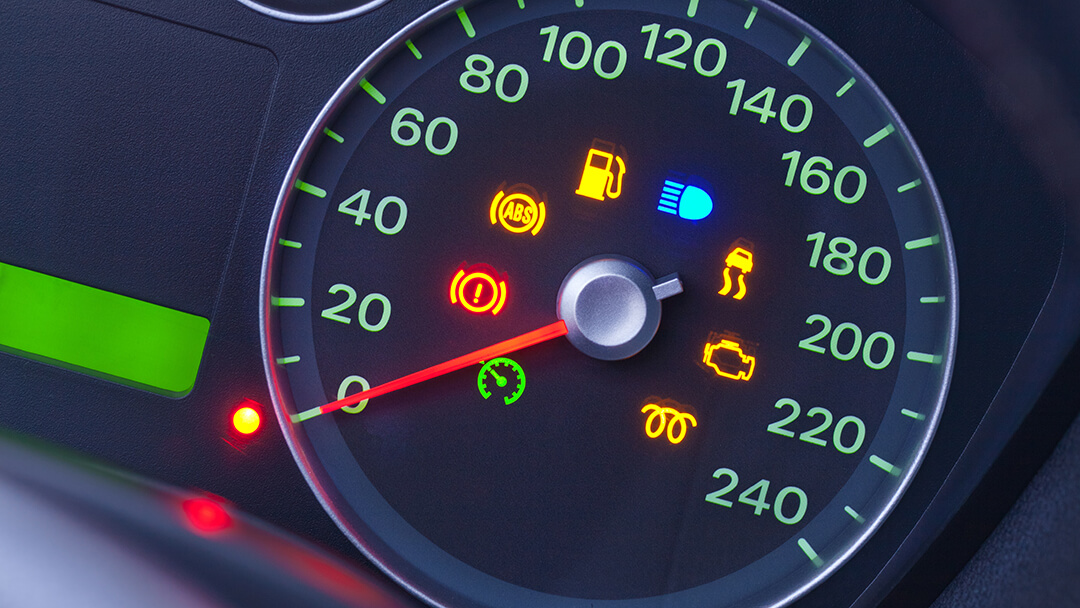It seems the amount of lights and symbols on the car dashboard just keeps increasing with modern cars. Our cars are now filled with electronic systems like stability controls and sensors that help us drive better.
These new features are perhaps keeping us safer but when something happens, it can be tricky to figure out what that warning light is connected to. Understanding the dashboard warning lights in your car is extremely important to not just fix the issue but to understand how severe it is and what it means for the journey you’re on.
There are some differences between car makes and models but the most important symbols remain the same and it’s key that you learn them all, which is why we’ve created a guide to dashboard warning lights for you.
Colours of dashboard warning lights
The colours of the warning lights are an easy start. Whichever symbol you see blinking on your dashboard, its colour could tell you the first thing.
Red light indicates a potential serious problem that requires professional assistance as soon as possible. Depending on which light this is, make sure you take care of this before continuing to drive long distances.
Orange, or amber, light requires your attention and is still likely to require servicing.
Green, or blue, light doesn’t indicate a serious problem but could still require action. There’s nothing to urgently worry about, but your screenwash light might go off in blue which means you’ll need to top it up.
Now that you know the importance of warning light colours, we’ll look at the most common symbols you may have on your dashboard.

Battery charge warning light
In most cars the battery warning light appears when the ignition is turned on and should go off as soon as the engine starts. If this doesn’t happen, or the symbol lights up when you’re driving, there may be an issue with your charging system. This light could also refer to your alternator so it’s advised to get to a safe location and switch off the engine to prevent further damage. You should seek professional help to fix it and determine the car is safe to drive.

Oil pressure warning light
Similarly to the car battery, this warning symbol should light up when switching on the car and disappear when the engine is on. If it stays on or lights up during your drive, stop as soon as possible, switch off the engine and check your oil levels. Read your owner’s manual if you’re not sure how. If the oil level is where it should be, despite of the warning light, don’t restart the engine until you seek professional advice.

Engine warning light
Again, this warning light shows up and disappears when starting your car. If you see it when the engine is running, there could be a malfunction with the engine itself, or the ECU (Electronic Control Unit) system. This as well could be serious and requires professional assistance. If the light flashes while driving, you should reduce your speed immediately until the flashing stops.

ABS warning light
The ABS light also shows the driver the system is operational when the ignition is switched on. ABS stands for Anti-Lock Braking System. If this warning light comes on again while driving, this means there’s a malfunction – your brakes will work normally but the ABS might not work if you need an emergency stop. It’s a useful feature to have so it’s worth having checked if the light is on.

Brake warning light
The brakes are probably the most important feature in your car so if this warning light flashes on whilst driving, it’s best to get it checked immediately. If both the brake light and the ABS warning light come on at the same time, stop your car as soon as it’s safe, using the brakes carefully.

Tyre pressure warning light
Most modern cars have systems monitoring tyre pressures nowadays. If this light switches on, it’s indicating that there’s a deviation from normal tyre pressures, possibly a puncture. These systems are quite sensitive but even if you don’t feel any difference in your tyres whilst driving, it’s good to get it checked as soon as possible. A tyre breaking from a puncture is a serious danger!

Airbag warning light
This is major when it comes to your safety – a faulty airbag might not go off in a crash, which could be what makes the accident fatal for you. A fault in the airbag could also mean it’ll deploy out of nowhere. If this light switches on, get your car checked as soon as possible.
If you see a warning light go on in your dashboard, but don’t know what it means, check your car’s handbook for a detailed explanation and what you should do. There are many warning lights that are specific to a car make or model.
You should never ignore a dashboard warning light – even something little could get worse and worse causing you danger or at least an expensive repair bill. MOT tests include checks on warning light functions so it’s another reason to make sure everything’s working. Poor vehicle condition could also lead to a conviction – driving with defective brakes or steering, for example, could get you 3 penalty points.
